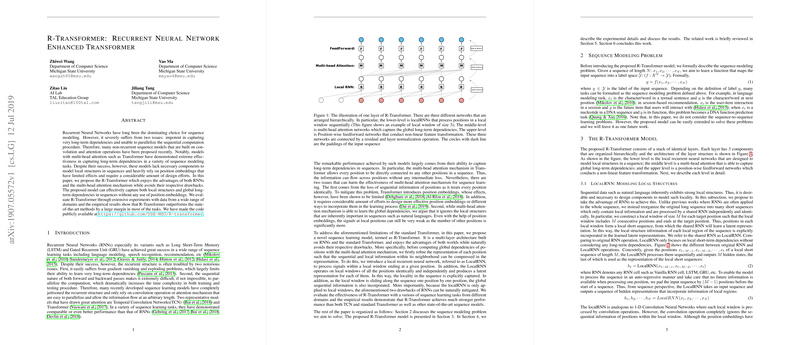An Overview of R-Transformer: Integrating RNNs into Transformer Architectures for Enhanced Sequence Modeling
The research paper titled "R-Transformer: Recurrent Neural Network Enhanced Transformer" by Zhiwei Wang et al. introduces an innovative approach for sequence modeling that amalgamates the strengths of Recurrent Neural Networks (RNNs) with the attention mechanisms of Transformers, while circumventing the inherent weaknesses of each paradigm. This work primarily addresses the limitations of existing sequence models in capturing both local and global dependencies in sequential data.
Introduction and Motivation
Traditional RNNs, despite their variants such as LSTM and GRU, suffer from well-documented issues regarding the vanishing and exploding gradient problems and lack of parallelization. These deficiencies restrict their effectiveness in learning long-term dependencies across sequential data. Conversely, while Transformers equipped with multi-head attention mechanisms have demonstrated proficiency in capturing global dependencies, they falter in effectively modeling local structures due to their reliance on position embeddings, which have proven to be suboptimal without extensive customization.
The R-Transformer Model
The authors propose the R-Transformer model, which aims to leverage the temporal memorization capacity of RNNs and the parallel processing capability and global dependency capture of Transformers. The architecture consists of multiple layers, each comprising distinct components that contribute to its performance:
- LocalRNN: Operating at the base level, the LocalRNN focuses on small, localized windows within the sequence. Unlike standard RNNs, which process entire sequences recursively, LocalRNN is applied to these local windows to efficiently capture local sequential features. This adjustment effectively mitigates the typical challenges faced by RNNs, such as computation inefficiency and difficulty with long-term sequence memorization.
- Multi-Head Attention: Positioned above the LocalRNN, this layer integrates attention mechanisms capable of directly connecting every position in the sequence, thereby overcoming the limitations of local dependency capture and ensuring robust modeling of long-term dependencies.
- Hierarchical Integration and Non-Linear Transformation: Finally, the model incorporates a position-wise feedforward network, accompanied by residual and layer normalization mechanisms. This integration refines the feature transformations, preserving both local and global information throughout the learning process.
Empirical Evaluation and Comparative Analysis
The R-Transformer was comprehensively evaluated on a spectrum of sequence modeling tasks, spanning domains such as image recognition (pixel-by-pixel MNIST), polyphonic music modeling, and LLMing (both character-level and word-level tasks on the PennTreebank dataset). The empirical results indicate that R-Transformer consistently exceeds the performance of state-of-the-art models, including TCNs and standard Transformers, across multiple tasks.
Significantly, R-Transformer achieves superior results in sequence tasks that involve strong local dependencies—an area where traditional Transformers commonly underperform. For instance, in the Nottingham dataset for polyphonic music modeling, and PennTreebank for character-level LLMing, R-Transformer outperformed competing models by notable margins in negative log-likelihood scores.
Implications and Future Directions
The findings underscore the efficacy of integrating local dependency modeling into global attention frameworks, positioning R-Transformer as a viable generalist model for a variety of sequence learning tasks. The proposed model's avoidance of position embeddings also suggests potential reduction in design complexities for future application contexts.
Future research directions may involve extending the R-Transformer to sequence-to-sequence learning problems and evaluating its scalability and performance in industrial applications. Additionally, a deeper exploration into further optimizing local window sizes and layer-specific hyperparameters might yield additional gains in different application domains.
In summary, the R-Transformer represents a significant stride in sequence modeling, offering a balanced approach that maximizes the strengths of RNNs and Transformers while effectively countering their individual drawbacks.
